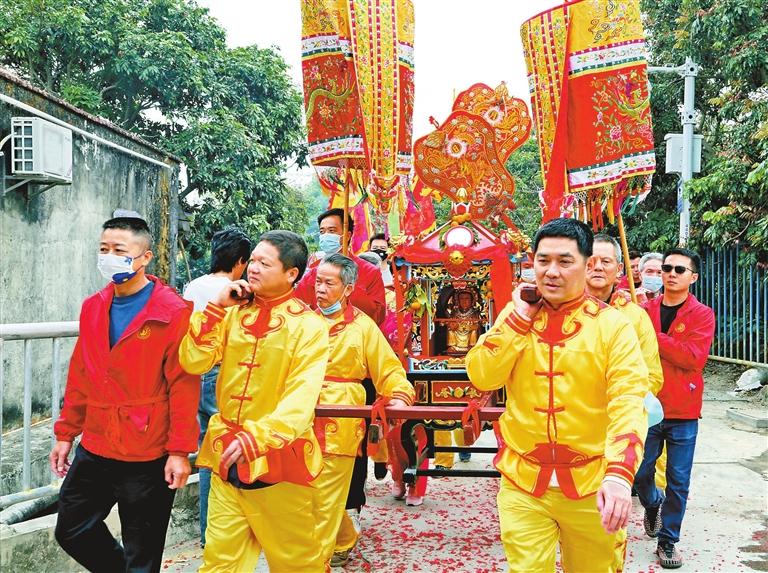

Chen Siqi vankochensq@163.com DAPENG Qingjiao, one of the most energetic and high-profile traditional folk activities in Dapeng New Area, recorded more than 10,000 participants during an eight-day celebration that ended Feb. 29 at Dapeng Fortress in the Pengcheng community. “We have been preparing for the Qingjiao ritual for more than a year and a half, and now that we have seen such a successful activity, I am really happy,” Lin Xinhui, director of the organizing committee of Dapeng Qingjiao, told Shenzhen Daily on Thursday as the crowds dispersed from the General’s Banquet, a feast held on the last day of the celebration. Dapeng Qingjiao, recognized in 2007 as an intangible cultural heritage in Guangdong Province, is a special ritual to worship Mazu, pay tribute to heroes, and pray for blessings and the prosperity of the nation and its people. Mazu is a revered Chinese sea goddess known for her role as a protector of mariners and fishermen. Qingjiao rituals originated in ancient China and are held in many coastal provinces such as Guangdong, Jiangxi, Fujian, and Zhejiang. According to Huang Wende, deputy director of Dapeng New Area Museum, Dapeng Qingjiao stands out due to its commemoration of ancient heroes, honoring the spirit of patriotism, and cultural diversity. This celebration, which dates back more than 600 years, features eight days of festivities that are held every five years around Chinese New Year. It involves a range of activities such as seeking divine blessings through prayer, a procession wherein participants carry an effigy of the goddess Mazu, performances, chanting, and liberating animals as a gesture of goodwill. The event culminates with the General’s Banquet, which marks the conclusion of the celebration. General’s Banquet “This is my first time attending the event. I came with my parents, but the festive mood here made me interested in the event,” a university student surnamed Zhang spiritedly said while attending the General’s Banquet on Thursday. As one of the highlights of the Dapeng Qingjiao event, the feast included more than 400 tables, featured 16 Dapeng traditional dishes, and attracted nearly 4,000 locals and visitors to attend. Huang explained that because Dapeng Fortress was an important defensive coastal base during the Ming (1368-1644) and Qing (1644-1912) dynasties, it served as a home to more than 10 generals over the years. The General’s Banquet, named after General Lai Enjue, evolved from banquets he held during the Qing Dynasty (1644-1912) to celebrate the Chinese New Year and other festivals, or to commemorate his recent military victories, with his soldiers and locals. The banquet has since become a traditional custom at Dapeng Fortress and is now the main event on the last-day of the eight-day Dapeng Qingjiao celebration. Devoting locals “I just raised a toast with our chefs, who prepared such wonderful dishes for us. I wanted to show my gratitude to them,” said Lin. This year, many locals were involved in preparations for the Dapeng Qingjiao event. The director of the organizing committee said more than 1,000 local residents of the Pengcheng community volunteered. “Especially for the parade on the fourth day, nearly 1,000 natives of all ages and genders took part,” Lin said. The group carried the statue of the goddess Mazu through the streets of Dapeng Fortress, accompanied by drum beats and songs. There was an impressive show of support from Chinese people residing overseas, as many came back for the ceremony. Feng Haoda, a Dapeng native currently living in the U.K., exemplified this when he mentioned that many of his friends who live abroad flew back to attend the event as well, hoping to offer a helping hand on site. Inheritance and protection “From attending the activity with my mom in the beginning to now, more than 50 years have passed, and things have changed,” Lin said. He was delighted as he observed many locals and tourists converging in jubilation to celebrate Dapeng Qingjiao. Furthermore, he extended his hope that younger generations will appreciate and inherit the tradition as a way to connect families around the world and to help people trace their roots. According to Huang, Dapeng Qingjiao integrates elements of intangible cultural heritage items, Dapeng local dishes, local folk songs, and handcrafted works. The museum’s duty is to research every aspect of it and understand the deeper meaning behind the practices. Huang emphasized the importance of cultural diversity, saying that it is as important as biodiversity. He is concerned that if skills and traditions are not inherited by younger generations, it will pose a challenge to cultural diversity in the future. As a next step, Huang said that the museum is seeking national recognition for Dapeng Qingjiao as an intangible cultural heritage in order to elevate the profile of the tradition and enhance appreciation of it. | 
